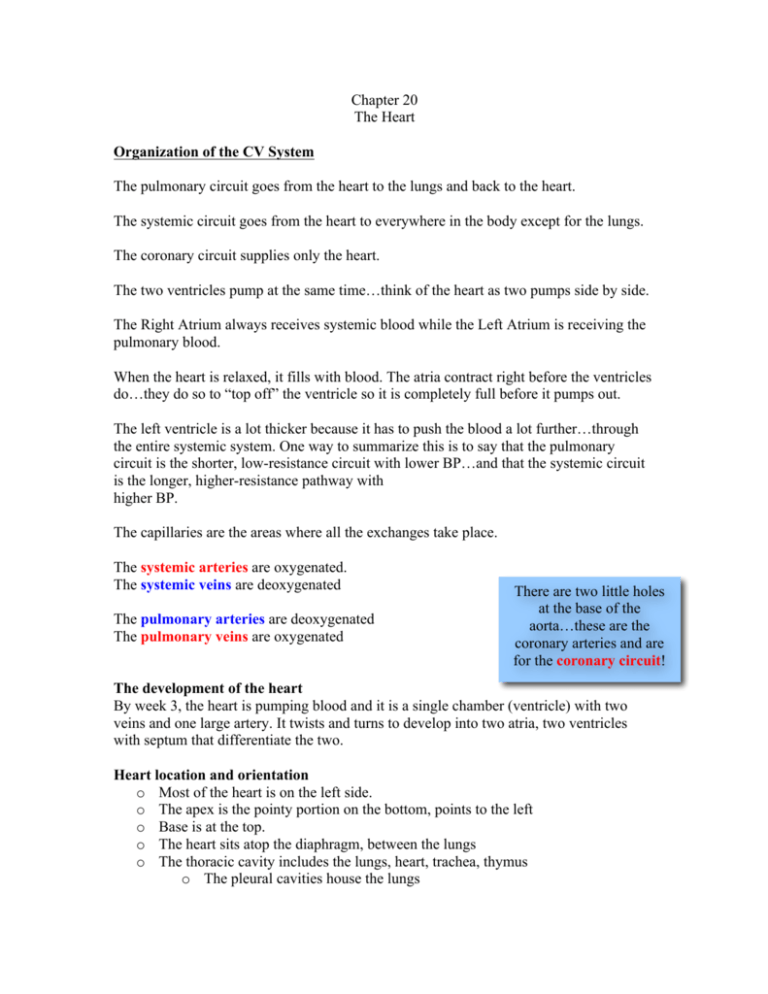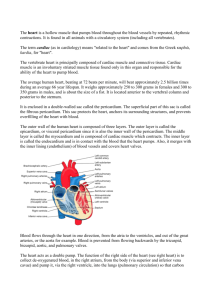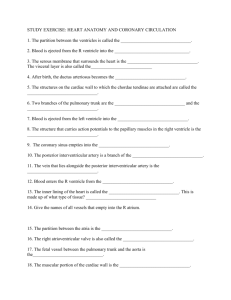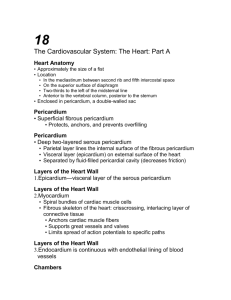A&P A The Heart
advertisement

Chapter 20 The Heart Organization of the CV System The pulmonary circuit goes from the heart to the lungs and back to the heart. The systemic circuit goes from the heart to everywhere in the body except for the lungs. The coronary circuit supplies only the heart. The two ventricles pump at the same time…think of the heart as two pumps side by side. The Right Atrium always receives systemic blood while the Left Atrium is receiving the pulmonary blood. When the heart is relaxed, it fills with blood. The atria contract right before the ventricles do…they do so to “top off” the ventricle so it is completely full before it pumps out. The left ventricle is a lot thicker because it has to push the blood a lot further…through the entire systemic system. One way to summarize this is to say that the pulmonary circuit is the shorter, low-resistance circuit with lower BP…and that the systemic circuit is the longer, higher-resistance pathway with higher BP. The capillaries are the areas where all the exchanges take place. The systemic arteries are oxygenated. The systemic veins are deoxygenated The pulmonary arteries are deoxygenated The pulmonary veins are oxygenated There are two little holes at the base of the aorta…these are the coronary arteries and are for the coronary circuit! The development of the heart By week 3, the heart is pumping blood and it is a single chamber (ventricle) with two veins and one large artery. It twists and turns to develop into two atria, two ventricles with septum that differentiate the two. Heart location and orientation o Most of the heart is on the left side. o The apex is the pointy portion on the bottom, points to the left o Base is at the top. o The heart sits atop the diaphragm, between the lungs o The thoracic cavity includes the lungs, heart, trachea, thymus o The pleural cavities house the lungs o The mediastinum houses the superior mediastinum and the pericardial activity § The heart is in the pericardial activity Pericardium The pericardium surrounds and lines the heart, forming the pericardial cavity within the mediastinum. o The outer layer is the fibrous pericardium…it surrounds the parietal layer and anchors the heart in position, connecting it to everything else around it. o The inner layer is a serous membrane called the serous pericardium. o The parietal pericardium is the side that lines the cavity o The visceral layer that is in contact with the heart is the visceral pericardium o The serous fluid of the pericardial cavity is pericardial fluid The serous membrane’s epithelial component is simple squamous epithelium = mesothelium Superficial Anatomy of the Heart The L/R Atria receive blood returning to the heart The L/R Ventricles pump blood out of the heart Auricles are external extensions of atria The coronary sulcus (atrioventricular groove) separates the atria and ventricles. The anterior interventricular sulcus separates LR ventricles anteriorly, and the posterior interventriculur sulcus separates LR ventricles posteriorly. Layers of the Heart Wall Endocardium: Simple squamous epithelium that is continuous with endothelium of vessels…it provides smooth surface for blood flow Myocardium: Forms bulk of the ventricles and atria…myo=muscle! It contains cardiomyocytes (contractile and autorhythmic cells), nerves, small coronary blood vessels/capillaries, and an extensive fibrous skeleton. The spiraling of the musculature makes the heart diameter smaller, twists it and pulls the apex toward the base when pumping. Epicardium: Structurally the same as the visceral layer of the serous membrane (visceral pericardium). It is made up of mesothelium (simple squamous epithelia) and the underlying areolar CT. Heart Chambers and Vessels The flow of blood goes like this: 1. Vena cava 2. Right atrium 3. Right atrioventricular valve (tricuspid valve) 4. Right ventricle 5. Pulmonary semilunar valve 6. Pulmonary trunk 7. R/L pulmonary arteries 8. Pulmonary capillaries 9. Pulmonary veins 10. Left atrium 11. Left atrioventricular valve (bicuspid valve, mitral valve) 12. Left ventricle 13. Aortic semilunar valve 14. Aorta 15. Systemic circulation 16. Systemic capillaries 17. Vena cava The Right Atrium Structures & Function R/L atria are separated by o Receives blood from: the interatrial septum o Superior vena cava o Inferior vena cava o Coronary sinus o Foramen ovale connects atria in fetus to bypass pulmonary circulation o Fossa ovalis is the remnant of the foramen ovale…now sealed off o Pectineate muscle is ridge-like myocardium The Right Ventricle Structures & Function o Receives blood from the right atrium o Right Atrioventricular Valve (aka tricuspid valve) prevents backflow into right atrium R/L ventricles are o Chordee Tendineae are collagen fibers that secure the separated by the valves during ventricular contraction interatrial septum o Papillary muscles anchor the chordae tendinae into position o Trabeculae carneae are the ridges of the myocardium o The ventricle pumps blood into the pulmonary trunk, which branches into the R/L pulmonary arteries…these go to the lungs o The pulmonary semilunar valve prevents backflow into the R ventricle The Left Atrium Structures & Function o Receives blood from the two LEFT pulmonary veins o Receives blood from the two RIGHT pulmonary veins The Left Ventricle Structures & Function o Receives blood from the left atrium o Left Atrioventricular Valve (bicuspid valve, mitral valve) prevents backflow into the left atrium o Chordeae Tendinae and Papillary Muscles (same as right ventricle) o Pumps blood into the aorta (ascending aorta to aortic arch to descending aorta) o Aortic semilunar valve prevents backflow into the left ventricle o Ligamentum arteriosum is fibrous CT that connects the aortic arch to the pulmonary trunk. It is a remnant of the ductus arteriosus, which is another duct in the fetal heart that allows the flow to bypass the pulmonary circuit. Fibrous Skeleton The fibrous skeleton is made up of bands of fibrous CT. It reinforces the valves and the base of the pulmonary trunk and aorta. It also electrically separates the atria and the ventricles. Myocardial connective tissue is collagen and elastic fibers that surround and interconnect contractile cells. It transmits force during contraction, provides route for nerves and vessels, and prevents over-stretching while providing elastic recoil during relaxation. Coronary Circulation Coronary circulation is just for the heart itself. The blood flows during diastole (relaxation). Arterial anastomoses provide collateral flow to the same area, which is protective…there is more than one way for the blood to get there. A major disorder of the coronary circulation is coronary artery disease (CAD). It includes a partial or complete block in artery (usually due to atherosclerosis or thrombus), which leads to insufficient blood flow (coronary ischema), and angina pectoris (chest pain) and/or myocardial infarction (necrosis). It is treated with cathetor and artherectomy, balloon angioplasty & stent, or coronary bypass surgery. Marieb, E. N. (2006). Essentials of human anatomy & physiology (8th ed.). San Francisco: Pearson/Benjamin Cummings. Martini, F., & Ober, W. C. (2006). Fundamentals of anatomy & physiology (7th ed.). San Francisco, CA: Pearson Benjamin Cummings.





